Strategic Marketing: Analysis of Tesco's Entry into New Zealand Market
VerifiedAdded on 2023/01/11
|12
|3874
|79
AI Summary
This report analyzes Tesco's entry into the New Zealand market, including macro-environment analysis, modes of entry, market segmentation, and Porter's generic strategies.
Contribute Materials
Your contribution can guide someone’s learning journey. Share your
documents today.

Strategic
Marketing
Marketing
Secure Best Marks with AI Grader
Need help grading? Try our AI Grader for instant feedback on your assignments.
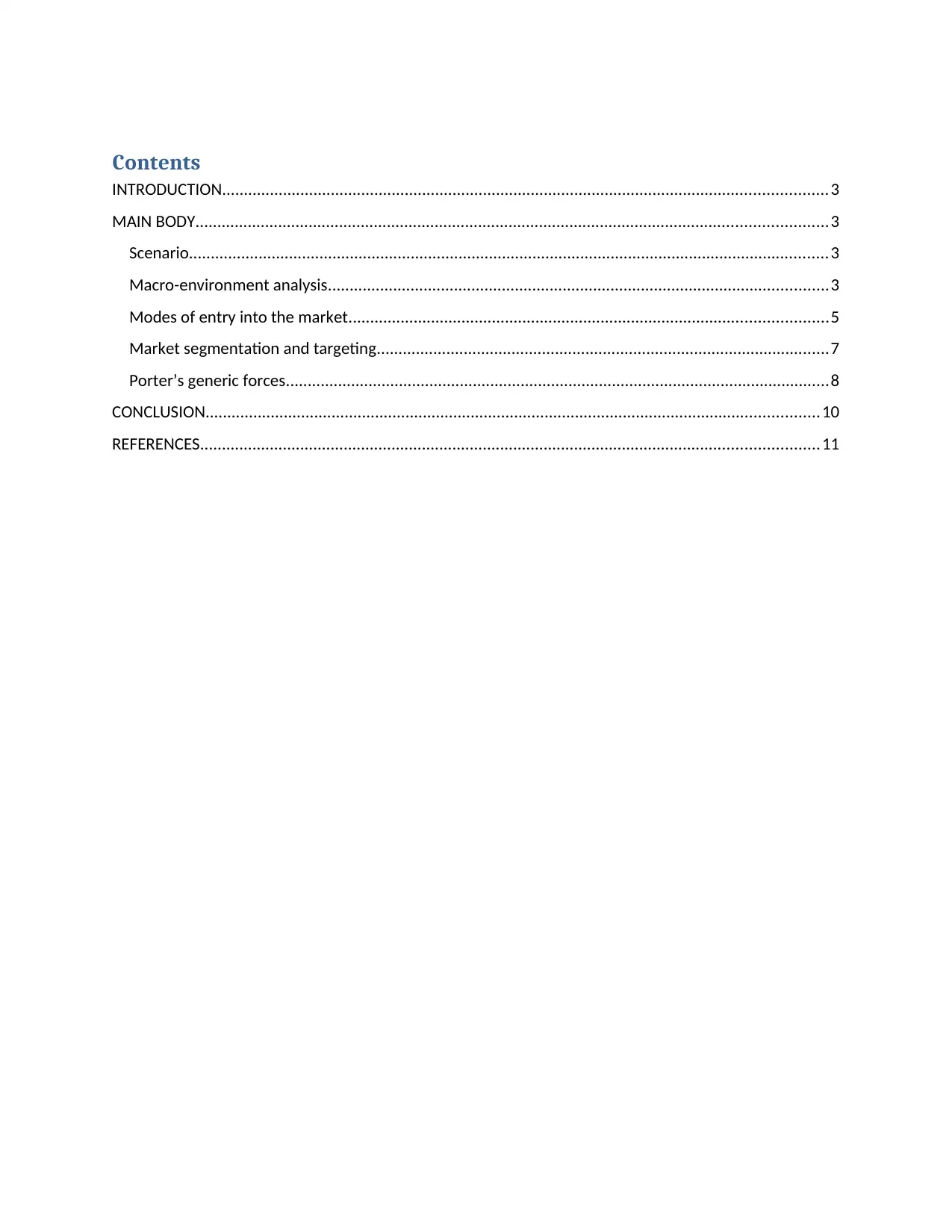
Contents
INTRODUCTION...........................................................................................................................................3
MAIN BODY.................................................................................................................................................3
Scenario...................................................................................................................................................3
Macro-environment analysis...................................................................................................................3
Modes of entry into the market..............................................................................................................5
Market segmentation and targeting........................................................................................................7
Porter’s generic forces.............................................................................................................................8
CONCLUSION.............................................................................................................................................10
REFERENCES..............................................................................................................................................11
INTRODUCTION...........................................................................................................................................3
MAIN BODY.................................................................................................................................................3
Scenario...................................................................................................................................................3
Macro-environment analysis...................................................................................................................3
Modes of entry into the market..............................................................................................................5
Market segmentation and targeting........................................................................................................7
Porter’s generic forces.............................................................................................................................8
CONCLUSION.............................................................................................................................................10
REFERENCES..............................................................................................................................................11
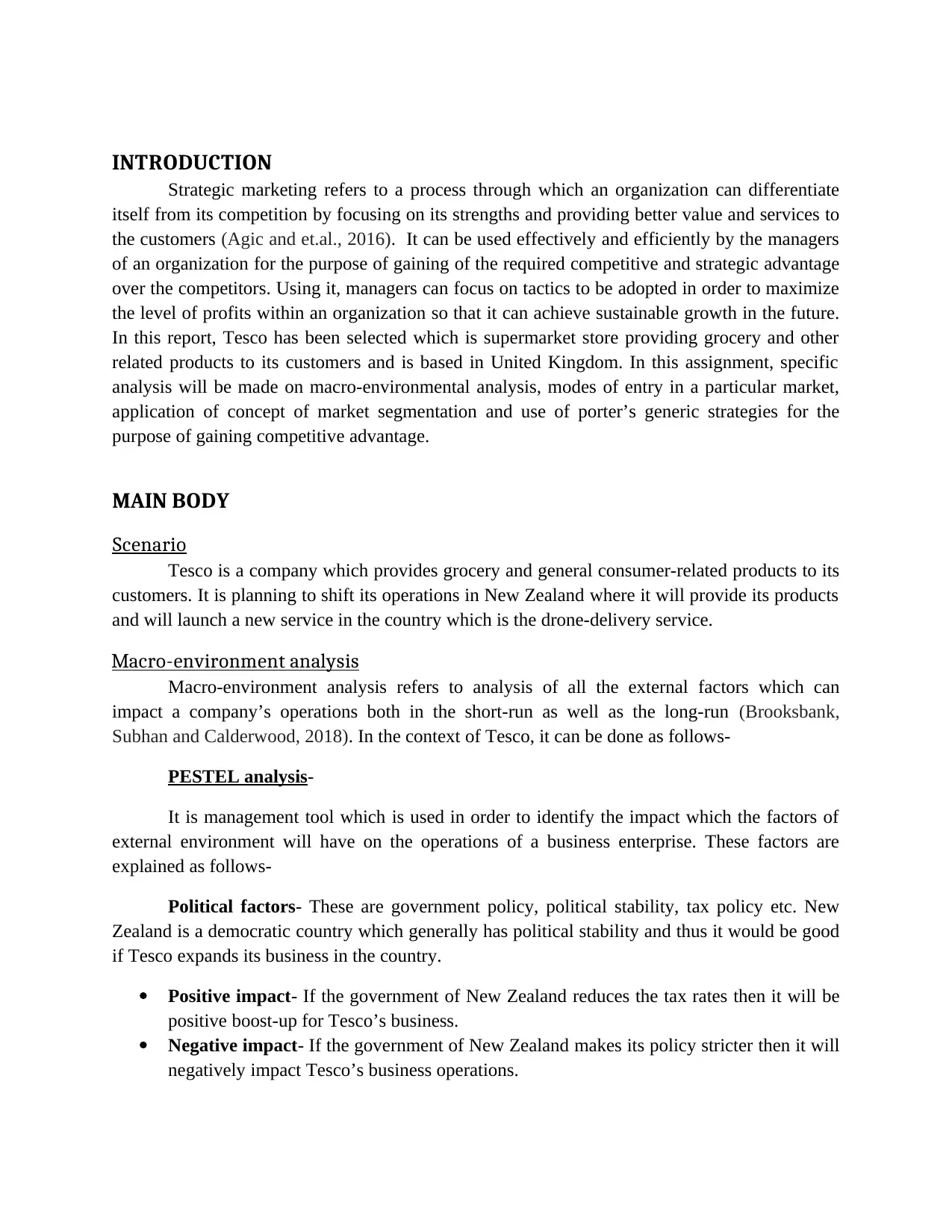
INTRODUCTION
Strategic marketing refers to a process through which an organization can differentiate
itself from its competition by focusing on its strengths and providing better value and services to
the customers (Agic and et.al., 2016). It can be used effectively and efficiently by the managers
of an organization for the purpose of gaining of the required competitive and strategic advantage
over the competitors. Using it, managers can focus on tactics to be adopted in order to maximize
the level of profits within an organization so that it can achieve sustainable growth in the future.
In this report, Tesco has been selected which is supermarket store providing grocery and other
related products to its customers and is based in United Kingdom. In this assignment, specific
analysis will be made on macro-environmental analysis, modes of entry in a particular market,
application of concept of market segmentation and use of porter’s generic strategies for the
purpose of gaining competitive advantage.
MAIN BODY
Scenario
Tesco is a company which provides grocery and general consumer-related products to its
customers. It is planning to shift its operations in New Zealand where it will provide its products
and will launch a new service in the country which is the drone-delivery service.
Macro-environment analysis
Macro-environment analysis refers to analysis of all the external factors which can
impact a company’s operations both in the short-run as well as the long-run (Brooksbank,
Subhan and Calderwood, 2018). In the context of Tesco, it can be done as follows-
PESTEL analysis-
It is management tool which is used in order to identify the impact which the factors of
external environment will have on the operations of a business enterprise. These factors are
explained as follows-
Political factors- These are government policy, political stability, tax policy etc. New
Zealand is a democratic country which generally has political stability and thus it would be good
if Tesco expands its business in the country.
Positive impact- If the government of New Zealand reduces the tax rates then it will be
positive boost-up for Tesco’s business.
Negative impact- If the government of New Zealand makes its policy stricter then it will
negatively impact Tesco’s business operations.
Strategic marketing refers to a process through which an organization can differentiate
itself from its competition by focusing on its strengths and providing better value and services to
the customers (Agic and et.al., 2016). It can be used effectively and efficiently by the managers
of an organization for the purpose of gaining of the required competitive and strategic advantage
over the competitors. Using it, managers can focus on tactics to be adopted in order to maximize
the level of profits within an organization so that it can achieve sustainable growth in the future.
In this report, Tesco has been selected which is supermarket store providing grocery and other
related products to its customers and is based in United Kingdom. In this assignment, specific
analysis will be made on macro-environmental analysis, modes of entry in a particular market,
application of concept of market segmentation and use of porter’s generic strategies for the
purpose of gaining competitive advantage.
MAIN BODY
Scenario
Tesco is a company which provides grocery and general consumer-related products to its
customers. It is planning to shift its operations in New Zealand where it will provide its products
and will launch a new service in the country which is the drone-delivery service.
Macro-environment analysis
Macro-environment analysis refers to analysis of all the external factors which can
impact a company’s operations both in the short-run as well as the long-run (Brooksbank,
Subhan and Calderwood, 2018). In the context of Tesco, it can be done as follows-
PESTEL analysis-
It is management tool which is used in order to identify the impact which the factors of
external environment will have on the operations of a business enterprise. These factors are
explained as follows-
Political factors- These are government policy, political stability, tax policy etc. New
Zealand is a democratic country which generally has political stability and thus it would be good
if Tesco expands its business in the country.
Positive impact- If the government of New Zealand reduces the tax rates then it will be
positive boost-up for Tesco’s business.
Negative impact- If the government of New Zealand makes its policy stricter then it will
negatively impact Tesco’s business operations.
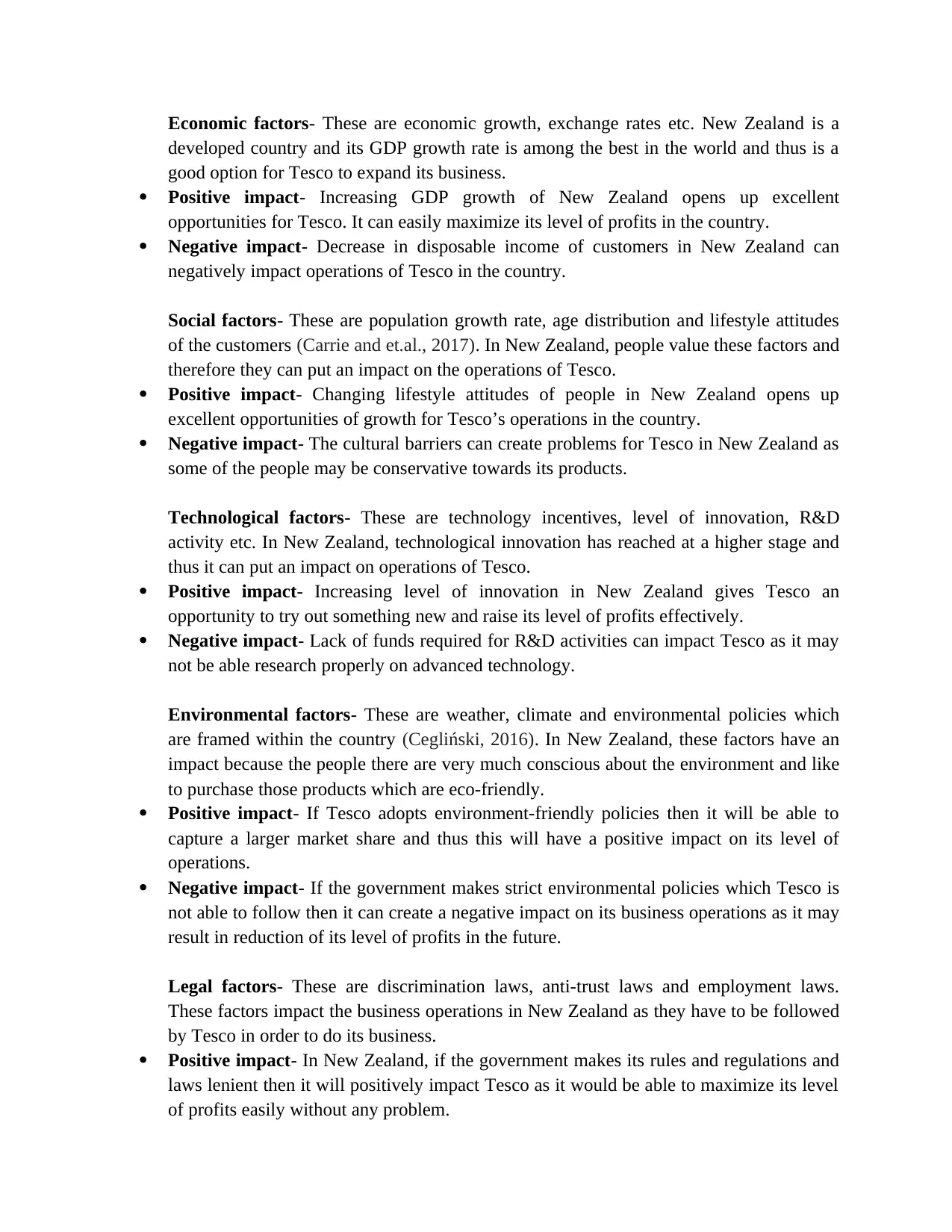
Economic factors- These are economic growth, exchange rates etc. New Zealand is a
developed country and its GDP growth rate is among the best in the world and thus is a
good option for Tesco to expand its business.
Positive impact- Increasing GDP growth of New Zealand opens up excellent
opportunities for Tesco. It can easily maximize its level of profits in the country.
Negative impact- Decrease in disposable income of customers in New Zealand can
negatively impact operations of Tesco in the country.
Social factors- These are population growth rate, age distribution and lifestyle attitudes
of the customers (Carrie and et.al., 2017). In New Zealand, people value these factors and
therefore they can put an impact on the operations of Tesco.
Positive impact- Changing lifestyle attitudes of people in New Zealand opens up
excellent opportunities of growth for Tesco’s operations in the country.
Negative impact- The cultural barriers can create problems for Tesco in New Zealand as
some of the people may be conservative towards its products.
Technological factors- These are technology incentives, level of innovation, R&D
activity etc. In New Zealand, technological innovation has reached at a higher stage and
thus it can put an impact on operations of Tesco.
Positive impact- Increasing level of innovation in New Zealand gives Tesco an
opportunity to try out something new and raise its level of profits effectively.
Negative impact- Lack of funds required for R&D activities can impact Tesco as it may
not be able research properly on advanced technology.
Environmental factors- These are weather, climate and environmental policies which
are framed within the country (Cegliński, 2016). In New Zealand, these factors have an
impact because the people there are very much conscious about the environment and like
to purchase those products which are eco-friendly.
Positive impact- If Tesco adopts environment-friendly policies then it will be able to
capture a larger market share and thus this will have a positive impact on its level of
operations.
Negative impact- If the government makes strict environmental policies which Tesco is
not able to follow then it can create a negative impact on its business operations as it may
result in reduction of its level of profits in the future.
Legal factors- These are discrimination laws, anti-trust laws and employment laws.
These factors impact the business operations in New Zealand as they have to be followed
by Tesco in order to do its business.
Positive impact- In New Zealand, if the government makes its rules and regulations and
laws lenient then it will positively impact Tesco as it would be able to maximize its level
of profits easily without any problem.
developed country and its GDP growth rate is among the best in the world and thus is a
good option for Tesco to expand its business.
Positive impact- Increasing GDP growth of New Zealand opens up excellent
opportunities for Tesco. It can easily maximize its level of profits in the country.
Negative impact- Decrease in disposable income of customers in New Zealand can
negatively impact operations of Tesco in the country.
Social factors- These are population growth rate, age distribution and lifestyle attitudes
of the customers (Carrie and et.al., 2017). In New Zealand, people value these factors and
therefore they can put an impact on the operations of Tesco.
Positive impact- Changing lifestyle attitudes of people in New Zealand opens up
excellent opportunities of growth for Tesco’s operations in the country.
Negative impact- The cultural barriers can create problems for Tesco in New Zealand as
some of the people may be conservative towards its products.
Technological factors- These are technology incentives, level of innovation, R&D
activity etc. In New Zealand, technological innovation has reached at a higher stage and
thus it can put an impact on operations of Tesco.
Positive impact- Increasing level of innovation in New Zealand gives Tesco an
opportunity to try out something new and raise its level of profits effectively.
Negative impact- Lack of funds required for R&D activities can impact Tesco as it may
not be able research properly on advanced technology.
Environmental factors- These are weather, climate and environmental policies which
are framed within the country (Cegliński, 2016). In New Zealand, these factors have an
impact because the people there are very much conscious about the environment and like
to purchase those products which are eco-friendly.
Positive impact- If Tesco adopts environment-friendly policies then it will be able to
capture a larger market share and thus this will have a positive impact on its level of
operations.
Negative impact- If the government makes strict environmental policies which Tesco is
not able to follow then it can create a negative impact on its business operations as it may
result in reduction of its level of profits in the future.
Legal factors- These are discrimination laws, anti-trust laws and employment laws.
These factors impact the business operations in New Zealand as they have to be followed
by Tesco in order to do its business.
Positive impact- In New Zealand, if the government makes its rules and regulations and
laws lenient then it will positively impact Tesco as it would be able to maximize its level
of profits easily without any problem.
Secure Best Marks with AI Grader
Need help grading? Try our AI Grader for instant feedback on your assignments.
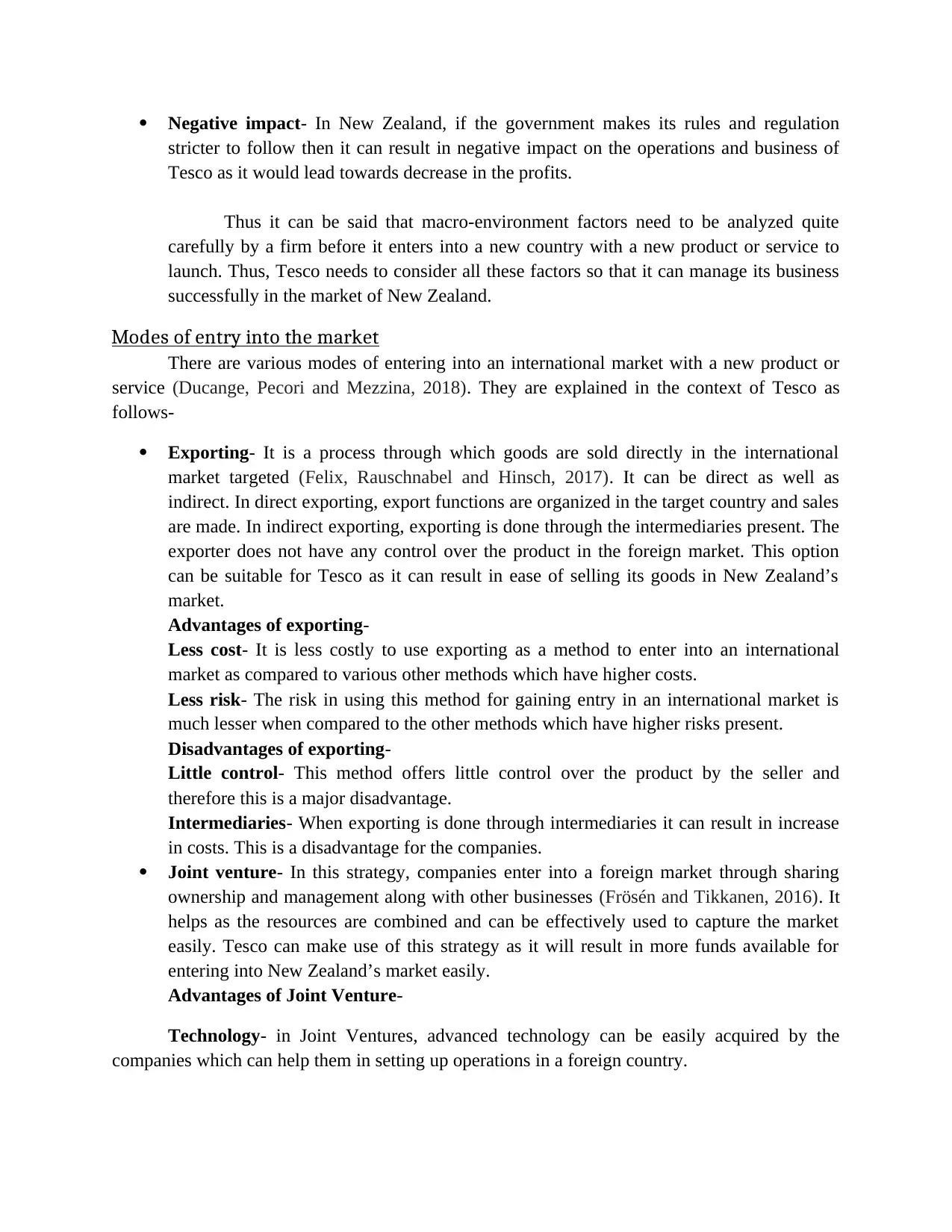
Negative impact- In New Zealand, if the government makes its rules and regulation
stricter to follow then it can result in negative impact on the operations and business of
Tesco as it would lead towards decrease in the profits.
Thus it can be said that macro-environment factors need to be analyzed quite
carefully by a firm before it enters into a new country with a new product or service to
launch. Thus, Tesco needs to consider all these factors so that it can manage its business
successfully in the market of New Zealand.
Modes of entry into the market
There are various modes of entering into an international market with a new product or
service (Ducange, Pecori and Mezzina, 2018). They are explained in the context of Tesco as
follows-
Exporting- It is a process through which goods are sold directly in the international
market targeted (Felix, Rauschnabel and Hinsch, 2017). It can be direct as well as
indirect. In direct exporting, export functions are organized in the target country and sales
are made. In indirect exporting, exporting is done through the intermediaries present. The
exporter does not have any control over the product in the foreign market. This option
can be suitable for Tesco as it can result in ease of selling its goods in New Zealand’s
market.
Advantages of exporting-
Less cost- It is less costly to use exporting as a method to enter into an international
market as compared to various other methods which have higher costs.
Less risk- The risk in using this method for gaining entry in an international market is
much lesser when compared to the other methods which have higher risks present.
Disadvantages of exporting-
Little control- This method offers little control over the product by the seller and
therefore this is a major disadvantage.
Intermediaries- When exporting is done through intermediaries it can result in increase
in costs. This is a disadvantage for the companies.
Joint venture- In this strategy, companies enter into a foreign market through sharing
ownership and management along with other businesses (Frösén and Tikkanen, 2016). It
helps as the resources are combined and can be effectively used to capture the market
easily. Tesco can make use of this strategy as it will result in more funds available for
entering into New Zealand’s market easily.
Advantages of Joint Venture-
Technology- in Joint Ventures, advanced technology can be easily acquired by the
companies which can help them in setting up operations in a foreign country.
stricter to follow then it can result in negative impact on the operations and business of
Tesco as it would lead towards decrease in the profits.
Thus it can be said that macro-environment factors need to be analyzed quite
carefully by a firm before it enters into a new country with a new product or service to
launch. Thus, Tesco needs to consider all these factors so that it can manage its business
successfully in the market of New Zealand.
Modes of entry into the market
There are various modes of entering into an international market with a new product or
service (Ducange, Pecori and Mezzina, 2018). They are explained in the context of Tesco as
follows-
Exporting- It is a process through which goods are sold directly in the international
market targeted (Felix, Rauschnabel and Hinsch, 2017). It can be direct as well as
indirect. In direct exporting, export functions are organized in the target country and sales
are made. In indirect exporting, exporting is done through the intermediaries present. The
exporter does not have any control over the product in the foreign market. This option
can be suitable for Tesco as it can result in ease of selling its goods in New Zealand’s
market.
Advantages of exporting-
Less cost- It is less costly to use exporting as a method to enter into an international
market as compared to various other methods which have higher costs.
Less risk- The risk in using this method for gaining entry in an international market is
much lesser when compared to the other methods which have higher risks present.
Disadvantages of exporting-
Little control- This method offers little control over the product by the seller and
therefore this is a major disadvantage.
Intermediaries- When exporting is done through intermediaries it can result in increase
in costs. This is a disadvantage for the companies.
Joint venture- In this strategy, companies enter into a foreign market through sharing
ownership and management along with other businesses (Frösén and Tikkanen, 2016). It
helps as the resources are combined and can be effectively used to capture the market
easily. Tesco can make use of this strategy as it will result in more funds available for
entering into New Zealand’s market easily.
Advantages of Joint Venture-
Technology- in Joint Ventures, advanced technology can be easily acquired by the
companies which can help them in setting up operations in a foreign country.
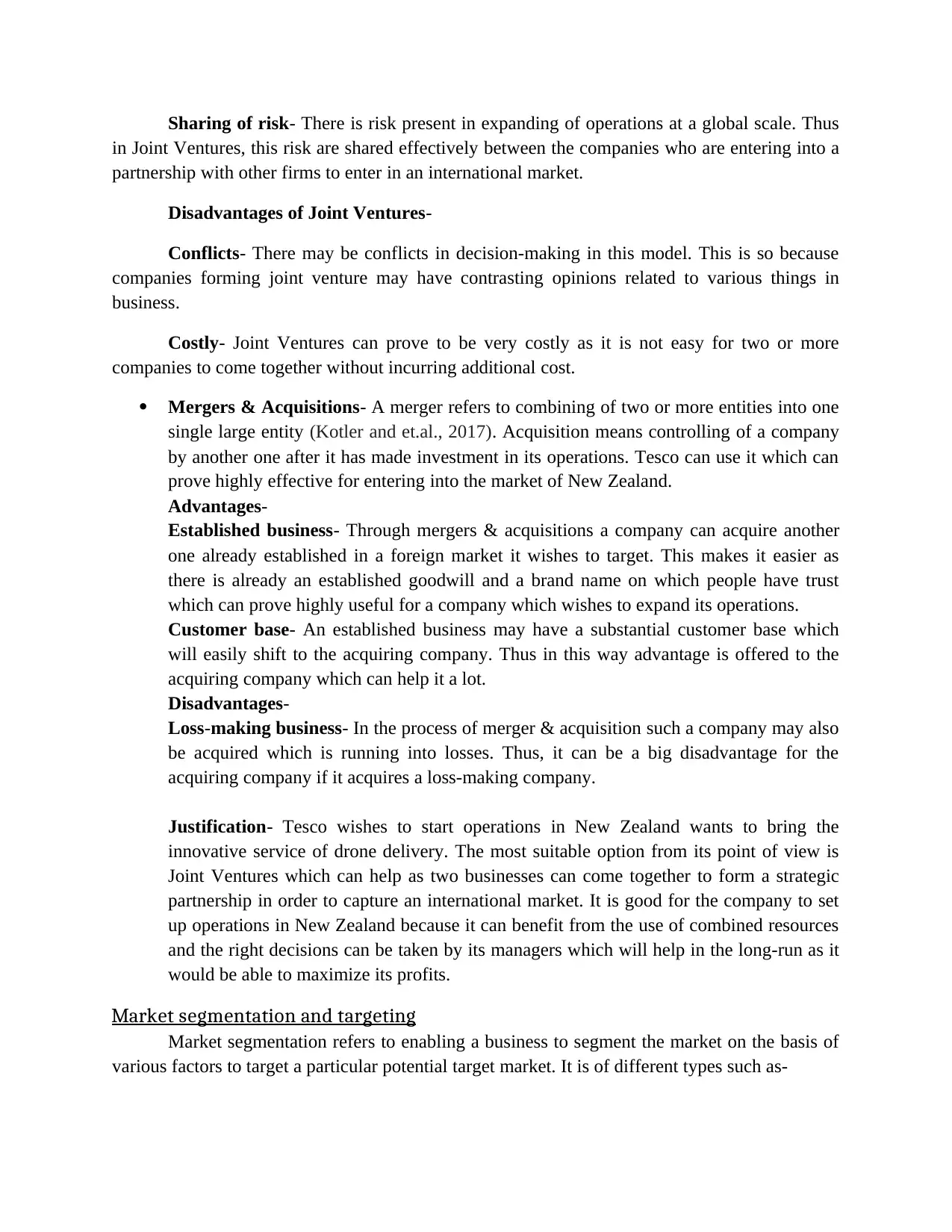
Sharing of risk- There is risk present in expanding of operations at a global scale. Thus
in Joint Ventures, this risk are shared effectively between the companies who are entering into a
partnership with other firms to enter in an international market.
Disadvantages of Joint Ventures-
Conflicts- There may be conflicts in decision-making in this model. This is so because
companies forming joint venture may have contrasting opinions related to various things in
business.
Costly- Joint Ventures can prove to be very costly as it is not easy for two or more
companies to come together without incurring additional cost.
Mergers & Acquisitions- A merger refers to combining of two or more entities into one
single large entity (Kotler and et.al., 2017). Acquisition means controlling of a company
by another one after it has made investment in its operations. Tesco can use it which can
prove highly effective for entering into the market of New Zealand.
Advantages-
Established business- Through mergers & acquisitions a company can acquire another
one already established in a foreign market it wishes to target. This makes it easier as
there is already an established goodwill and a brand name on which people have trust
which can prove highly useful for a company which wishes to expand its operations.
Customer base- An established business may have a substantial customer base which
will easily shift to the acquiring company. Thus in this way advantage is offered to the
acquiring company which can help it a lot.
Disadvantages-
Loss-making business- In the process of merger & acquisition such a company may also
be acquired which is running into losses. Thus, it can be a big disadvantage for the
acquiring company if it acquires a loss-making company.
Justification- Tesco wishes to start operations in New Zealand wants to bring the
innovative service of drone delivery. The most suitable option from its point of view is
Joint Ventures which can help as two businesses can come together to form a strategic
partnership in order to capture an international market. It is good for the company to set
up operations in New Zealand because it can benefit from the use of combined resources
and the right decisions can be taken by its managers which will help in the long-run as it
would be able to maximize its profits.
Market segmentation and targeting
Market segmentation refers to enabling a business to segment the market on the basis of
various factors to target a particular potential target market. It is of different types such as-
in Joint Ventures, this risk are shared effectively between the companies who are entering into a
partnership with other firms to enter in an international market.
Disadvantages of Joint Ventures-
Conflicts- There may be conflicts in decision-making in this model. This is so because
companies forming joint venture may have contrasting opinions related to various things in
business.
Costly- Joint Ventures can prove to be very costly as it is not easy for two or more
companies to come together without incurring additional cost.
Mergers & Acquisitions- A merger refers to combining of two or more entities into one
single large entity (Kotler and et.al., 2017). Acquisition means controlling of a company
by another one after it has made investment in its operations. Tesco can use it which can
prove highly effective for entering into the market of New Zealand.
Advantages-
Established business- Through mergers & acquisitions a company can acquire another
one already established in a foreign market it wishes to target. This makes it easier as
there is already an established goodwill and a brand name on which people have trust
which can prove highly useful for a company which wishes to expand its operations.
Customer base- An established business may have a substantial customer base which
will easily shift to the acquiring company. Thus in this way advantage is offered to the
acquiring company which can help it a lot.
Disadvantages-
Loss-making business- In the process of merger & acquisition such a company may also
be acquired which is running into losses. Thus, it can be a big disadvantage for the
acquiring company if it acquires a loss-making company.
Justification- Tesco wishes to start operations in New Zealand wants to bring the
innovative service of drone delivery. The most suitable option from its point of view is
Joint Ventures which can help as two businesses can come together to form a strategic
partnership in order to capture an international market. It is good for the company to set
up operations in New Zealand because it can benefit from the use of combined resources
and the right decisions can be taken by its managers which will help in the long-run as it
would be able to maximize its profits.
Market segmentation and targeting
Market segmentation refers to enabling a business to segment the market on the basis of
various factors to target a particular potential target market. It is of different types such as-
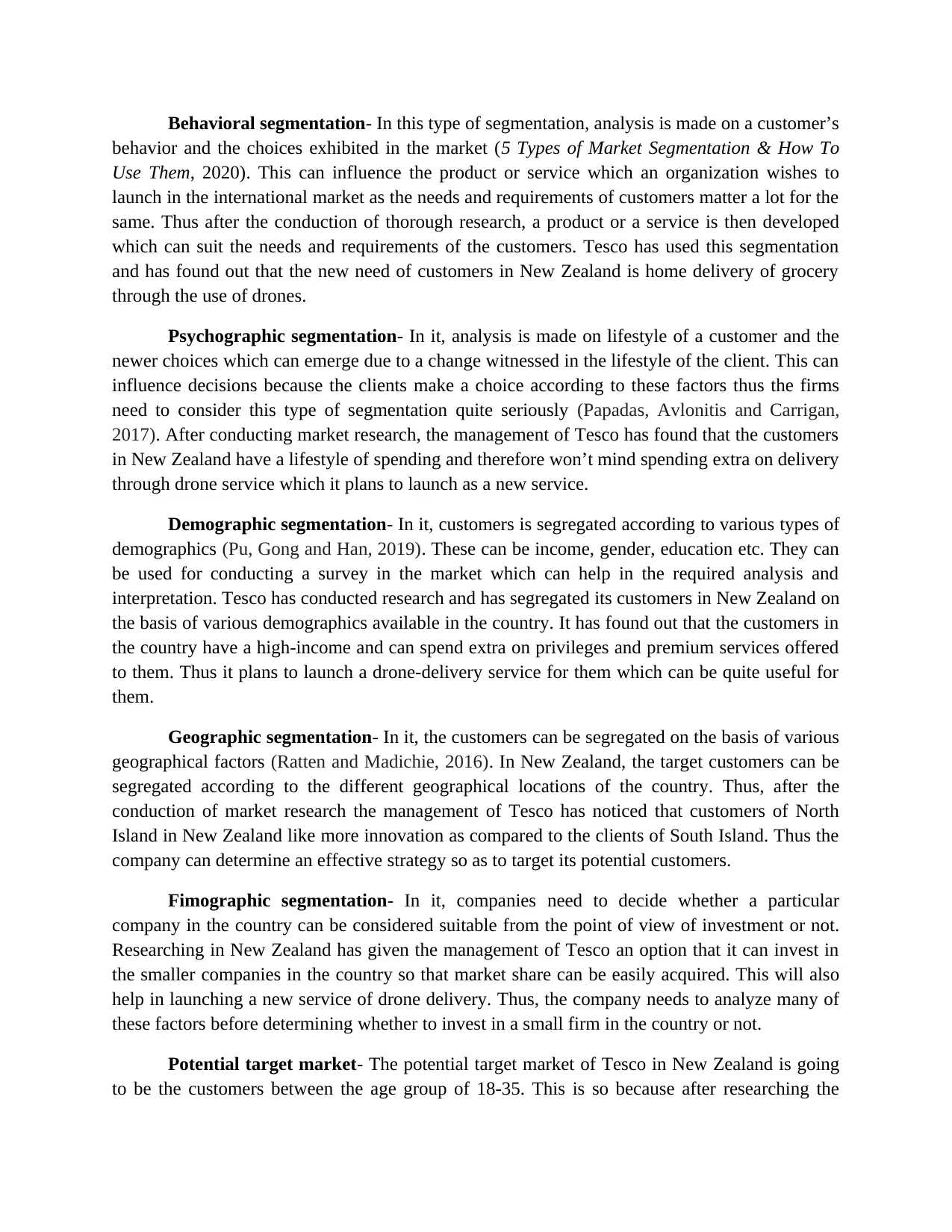
Behavioral segmentation- In this type of segmentation, analysis is made on a customer’s
behavior and the choices exhibited in the market (5 Types of Market Segmentation & How To
Use Them, 2020). This can influence the product or service which an organization wishes to
launch in the international market as the needs and requirements of customers matter a lot for the
same. Thus after the conduction of thorough research, a product or a service is then developed
which can suit the needs and requirements of the customers. Tesco has used this segmentation
and has found out that the new need of customers in New Zealand is home delivery of grocery
through the use of drones.
Psychographic segmentation- In it, analysis is made on lifestyle of a customer and the
newer choices which can emerge due to a change witnessed in the lifestyle of the client. This can
influence decisions because the clients make a choice according to these factors thus the firms
need to consider this type of segmentation quite seriously (Papadas, Avlonitis and Carrigan,
2017). After conducting market research, the management of Tesco has found that the customers
in New Zealand have a lifestyle of spending and therefore won’t mind spending extra on delivery
through drone service which it plans to launch as a new service.
Demographic segmentation- In it, customers is segregated according to various types of
demographics (Pu, Gong and Han, 2019). These can be income, gender, education etc. They can
be used for conducting a survey in the market which can help in the required analysis and
interpretation. Tesco has conducted research and has segregated its customers in New Zealand on
the basis of various demographics available in the country. It has found out that the customers in
the country have a high-income and can spend extra on privileges and premium services offered
to them. Thus it plans to launch a drone-delivery service for them which can be quite useful for
them.
Geographic segmentation- In it, the customers can be segregated on the basis of various
geographical factors (Ratten and Madichie, 2016). In New Zealand, the target customers can be
segregated according to the different geographical locations of the country. Thus, after the
conduction of market research the management of Tesco has noticed that customers of North
Island in New Zealand like more innovation as compared to the clients of South Island. Thus the
company can determine an effective strategy so as to target its potential customers.
Fimographic segmentation- In it, companies need to decide whether a particular
company in the country can be considered suitable from the point of view of investment or not.
Researching in New Zealand has given the management of Tesco an option that it can invest in
the smaller companies in the country so that market share can be easily acquired. This will also
help in launching a new service of drone delivery. Thus, the company needs to analyze many of
these factors before determining whether to invest in a small firm in the country or not.
Potential target market- The potential target market of Tesco in New Zealand is going
to be the customers between the age group of 18-35. This is so because after researching the
behavior and the choices exhibited in the market (5 Types of Market Segmentation & How To
Use Them, 2020). This can influence the product or service which an organization wishes to
launch in the international market as the needs and requirements of customers matter a lot for the
same. Thus after the conduction of thorough research, a product or a service is then developed
which can suit the needs and requirements of the customers. Tesco has used this segmentation
and has found out that the new need of customers in New Zealand is home delivery of grocery
through the use of drones.
Psychographic segmentation- In it, analysis is made on lifestyle of a customer and the
newer choices which can emerge due to a change witnessed in the lifestyle of the client. This can
influence decisions because the clients make a choice according to these factors thus the firms
need to consider this type of segmentation quite seriously (Papadas, Avlonitis and Carrigan,
2017). After conducting market research, the management of Tesco has found that the customers
in New Zealand have a lifestyle of spending and therefore won’t mind spending extra on delivery
through drone service which it plans to launch as a new service.
Demographic segmentation- In it, customers is segregated according to various types of
demographics (Pu, Gong and Han, 2019). These can be income, gender, education etc. They can
be used for conducting a survey in the market which can help in the required analysis and
interpretation. Tesco has conducted research and has segregated its customers in New Zealand on
the basis of various demographics available in the country. It has found out that the customers in
the country have a high-income and can spend extra on privileges and premium services offered
to them. Thus it plans to launch a drone-delivery service for them which can be quite useful for
them.
Geographic segmentation- In it, the customers can be segregated on the basis of various
geographical factors (Ratten and Madichie, 2016). In New Zealand, the target customers can be
segregated according to the different geographical locations of the country. Thus, after the
conduction of market research the management of Tesco has noticed that customers of North
Island in New Zealand like more innovation as compared to the clients of South Island. Thus the
company can determine an effective strategy so as to target its potential customers.
Fimographic segmentation- In it, companies need to decide whether a particular
company in the country can be considered suitable from the point of view of investment or not.
Researching in New Zealand has given the management of Tesco an option that it can invest in
the smaller companies in the country so that market share can be easily acquired. This will also
help in launching a new service of drone delivery. Thus, the company needs to analyze many of
these factors before determining whether to invest in a small firm in the country or not.
Potential target market- The potential target market of Tesco in New Zealand is going
to be the customers between the age group of 18-35. This is so because after researching the
Paraphrase This Document
Need a fresh take? Get an instant paraphrase of this document with our AI Paraphraser
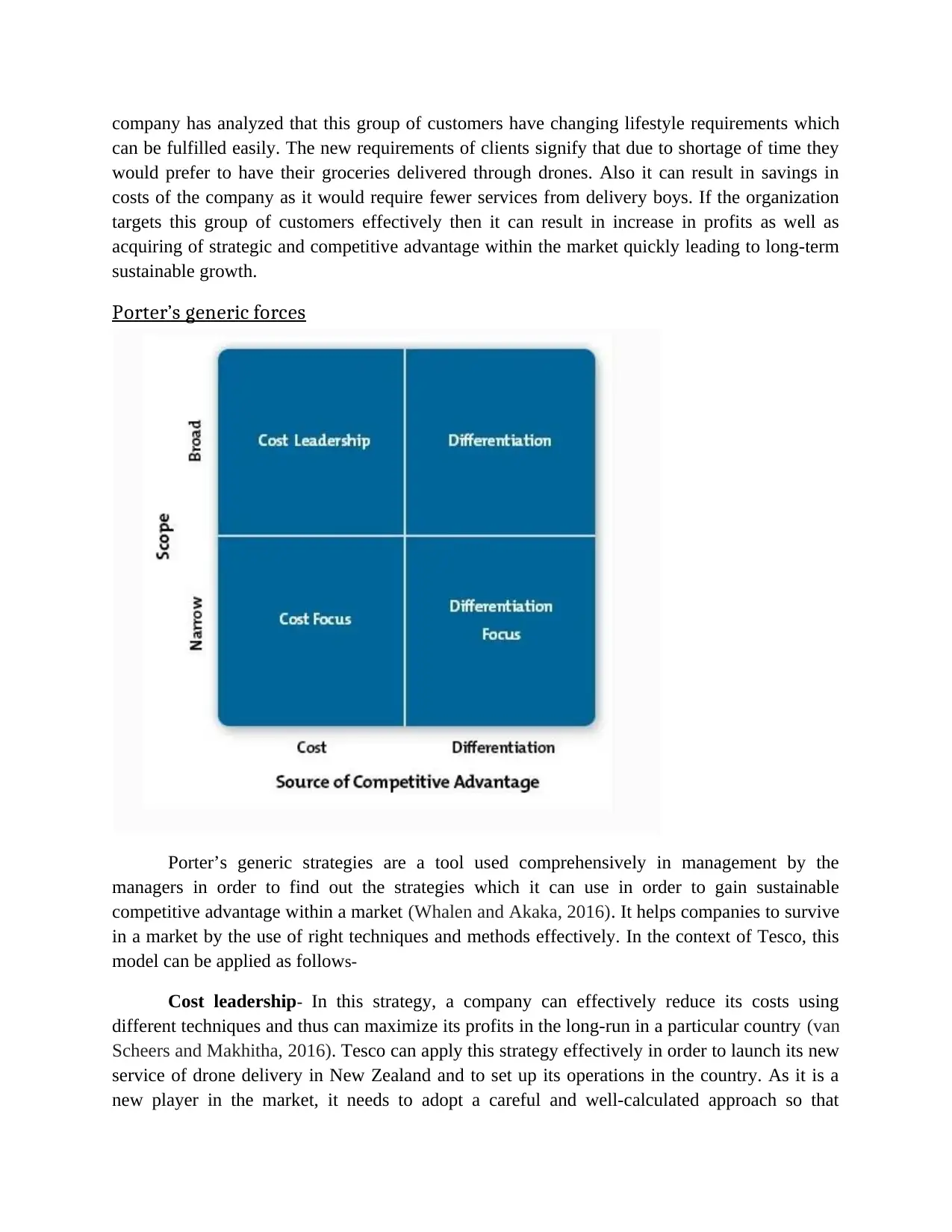
company has analyzed that this group of customers have changing lifestyle requirements which
can be fulfilled easily. The new requirements of clients signify that due to shortage of time they
would prefer to have their groceries delivered through drones. Also it can result in savings in
costs of the company as it would require fewer services from delivery boys. If the organization
targets this group of customers effectively then it can result in increase in profits as well as
acquiring of strategic and competitive advantage within the market quickly leading to long-term
sustainable growth.
Porter’s generic forces
Porter’s generic strategies are a tool used comprehensively in management by the
managers in order to find out the strategies which it can use in order to gain sustainable
competitive advantage within a market (Whalen and Akaka, 2016). It helps companies to survive
in a market by the use of right techniques and methods effectively. In the context of Tesco, this
model can be applied as follows-
Cost leadership- In this strategy, a company can effectively reduce its costs using
different techniques and thus can maximize its profits in the long-run in a particular country (van
Scheers and Makhitha, 2016). Tesco can apply this strategy effectively in order to launch its new
service of drone delivery in New Zealand and to set up its operations in the country. As it is a
new player in the market, it needs to adopt a careful and well-calculated approach so that
can be fulfilled easily. The new requirements of clients signify that due to shortage of time they
would prefer to have their groceries delivered through drones. Also it can result in savings in
costs of the company as it would require fewer services from delivery boys. If the organization
targets this group of customers effectively then it can result in increase in profits as well as
acquiring of strategic and competitive advantage within the market quickly leading to long-term
sustainable growth.
Porter’s generic forces
Porter’s generic strategies are a tool used comprehensively in management by the
managers in order to find out the strategies which it can use in order to gain sustainable
competitive advantage within a market (Whalen and Akaka, 2016). It helps companies to survive
in a market by the use of right techniques and methods effectively. In the context of Tesco, this
model can be applied as follows-
Cost leadership- In this strategy, a company can effectively reduce its costs using
different techniques and thus can maximize its profits in the long-run in a particular country (van
Scheers and Makhitha, 2016). Tesco can apply this strategy effectively in order to launch its new
service of drone delivery in New Zealand and to set up its operations in the country. As it is a
new player in the market, it needs to adopt a careful and well-calculated approach so that
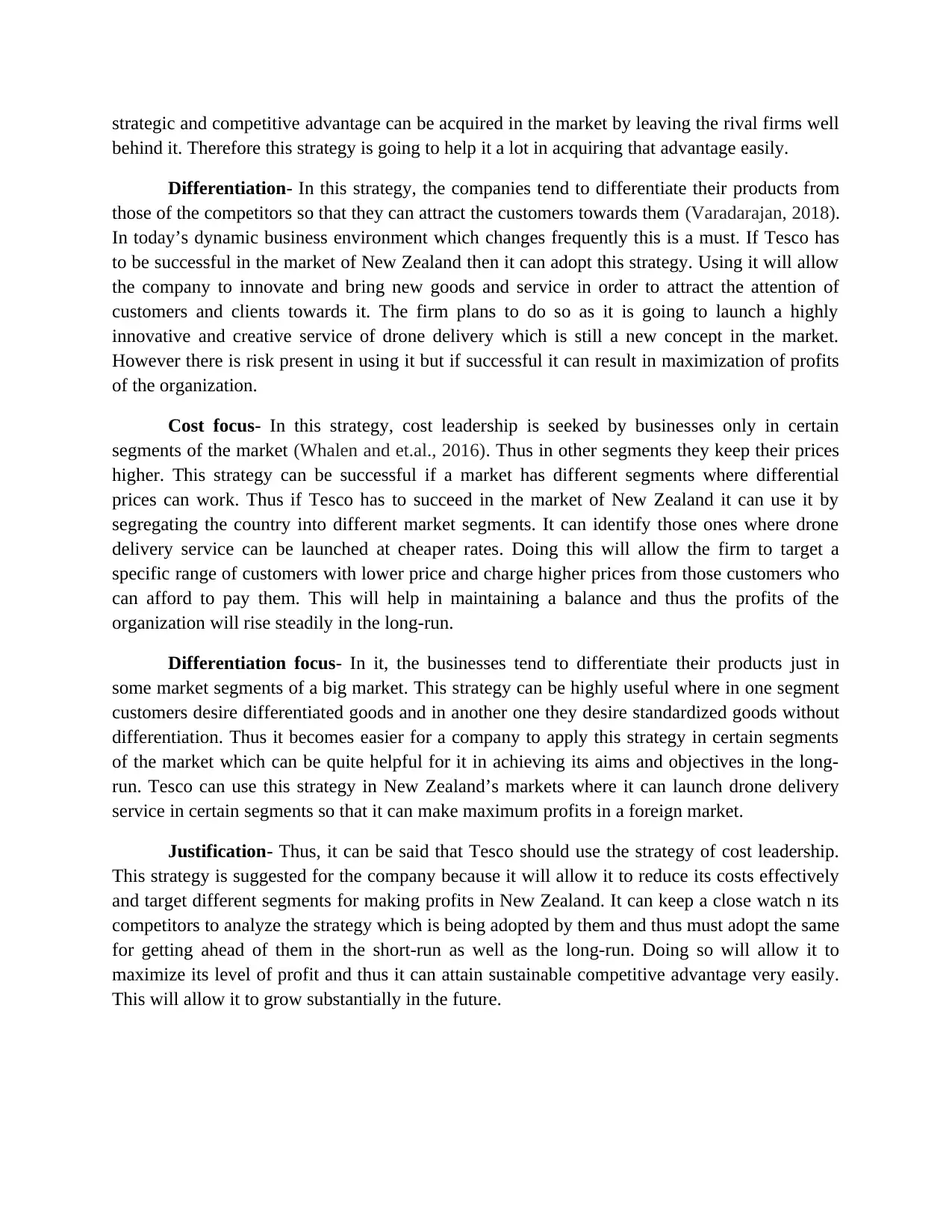
strategic and competitive advantage can be acquired in the market by leaving the rival firms well
behind it. Therefore this strategy is going to help it a lot in acquiring that advantage easily.
Differentiation- In this strategy, the companies tend to differentiate their products from
those of the competitors so that they can attract the customers towards them (Varadarajan, 2018).
In today’s dynamic business environment which changes frequently this is a must. If Tesco has
to be successful in the market of New Zealand then it can adopt this strategy. Using it will allow
the company to innovate and bring new goods and service in order to attract the attention of
customers and clients towards it. The firm plans to do so as it is going to launch a highly
innovative and creative service of drone delivery which is still a new concept in the market.
However there is risk present in using it but if successful it can result in maximization of profits
of the organization.
Cost focus- In this strategy, cost leadership is seeked by businesses only in certain
segments of the market (Whalen and et.al., 2016). Thus in other segments they keep their prices
higher. This strategy can be successful if a market has different segments where differential
prices can work. Thus if Tesco has to succeed in the market of New Zealand it can use it by
segregating the country into different market segments. It can identify those ones where drone
delivery service can be launched at cheaper rates. Doing this will allow the firm to target a
specific range of customers with lower price and charge higher prices from those customers who
can afford to pay them. This will help in maintaining a balance and thus the profits of the
organization will rise steadily in the long-run.
Differentiation focus- In it, the businesses tend to differentiate their products just in
some market segments of a big market. This strategy can be highly useful where in one segment
customers desire differentiated goods and in another one they desire standardized goods without
differentiation. Thus it becomes easier for a company to apply this strategy in certain segments
of the market which can be quite helpful for it in achieving its aims and objectives in the long-
run. Tesco can use this strategy in New Zealand’s markets where it can launch drone delivery
service in certain segments so that it can make maximum profits in a foreign market.
Justification- Thus, it can be said that Tesco should use the strategy of cost leadership.
This strategy is suggested for the company because it will allow it to reduce its costs effectively
and target different segments for making profits in New Zealand. It can keep a close watch n its
competitors to analyze the strategy which is being adopted by them and thus must adopt the same
for getting ahead of them in the short-run as well as the long-run. Doing so will allow it to
maximize its level of profit and thus it can attain sustainable competitive advantage very easily.
This will allow it to grow substantially in the future.
behind it. Therefore this strategy is going to help it a lot in acquiring that advantage easily.
Differentiation- In this strategy, the companies tend to differentiate their products from
those of the competitors so that they can attract the customers towards them (Varadarajan, 2018).
In today’s dynamic business environment which changes frequently this is a must. If Tesco has
to be successful in the market of New Zealand then it can adopt this strategy. Using it will allow
the company to innovate and bring new goods and service in order to attract the attention of
customers and clients towards it. The firm plans to do so as it is going to launch a highly
innovative and creative service of drone delivery which is still a new concept in the market.
However there is risk present in using it but if successful it can result in maximization of profits
of the organization.
Cost focus- In this strategy, cost leadership is seeked by businesses only in certain
segments of the market (Whalen and et.al., 2016). Thus in other segments they keep their prices
higher. This strategy can be successful if a market has different segments where differential
prices can work. Thus if Tesco has to succeed in the market of New Zealand it can use it by
segregating the country into different market segments. It can identify those ones where drone
delivery service can be launched at cheaper rates. Doing this will allow the firm to target a
specific range of customers with lower price and charge higher prices from those customers who
can afford to pay them. This will help in maintaining a balance and thus the profits of the
organization will rise steadily in the long-run.
Differentiation focus- In it, the businesses tend to differentiate their products just in
some market segments of a big market. This strategy can be highly useful where in one segment
customers desire differentiated goods and in another one they desire standardized goods without
differentiation. Thus it becomes easier for a company to apply this strategy in certain segments
of the market which can be quite helpful for it in achieving its aims and objectives in the long-
run. Tesco can use this strategy in New Zealand’s markets where it can launch drone delivery
service in certain segments so that it can make maximum profits in a foreign market.
Justification- Thus, it can be said that Tesco should use the strategy of cost leadership.
This strategy is suggested for the company because it will allow it to reduce its costs effectively
and target different segments for making profits in New Zealand. It can keep a close watch n its
competitors to analyze the strategy which is being adopted by them and thus must adopt the same
for getting ahead of them in the short-run as well as the long-run. Doing so will allow it to
maximize its level of profit and thus it can attain sustainable competitive advantage very easily.
This will allow it to grow substantially in the future.
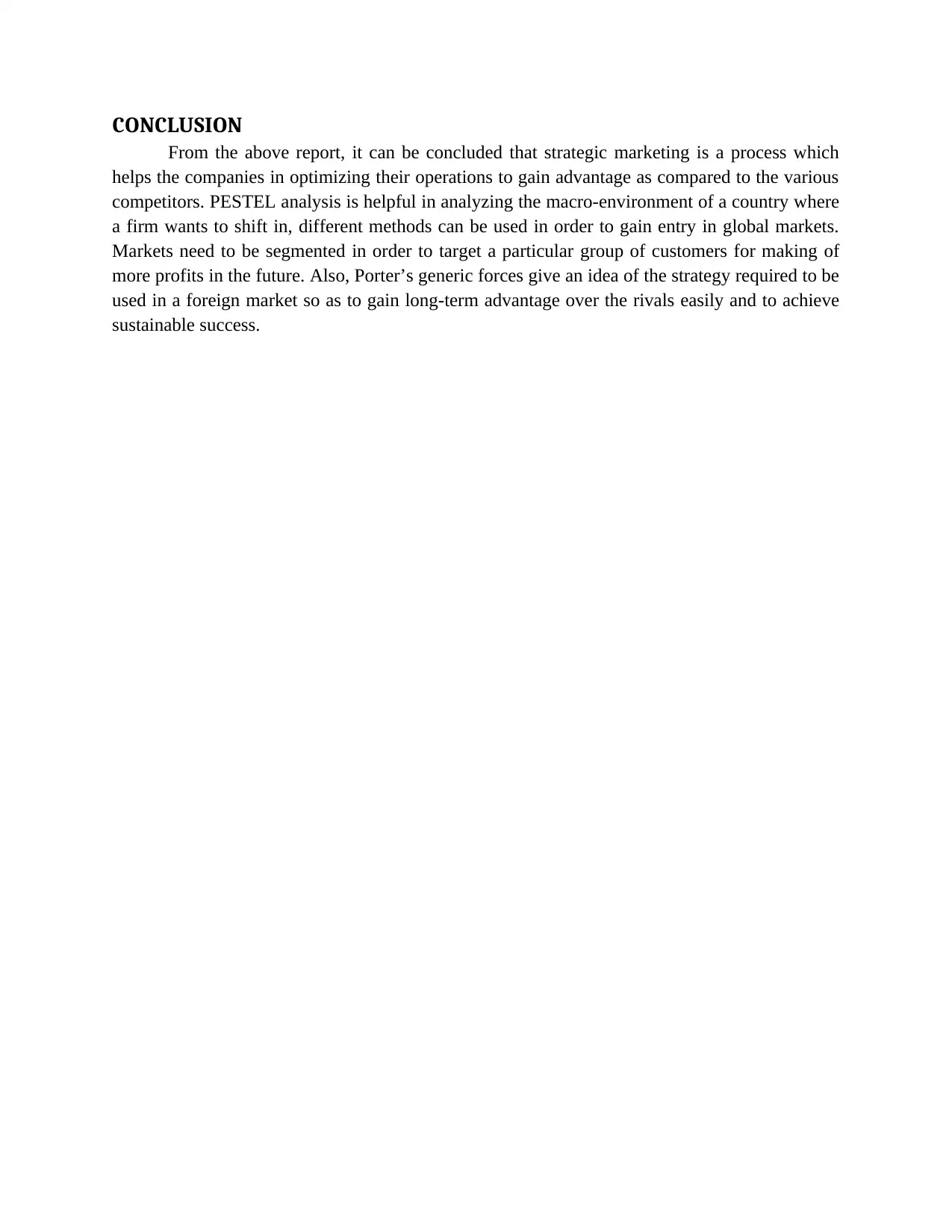
CONCLUSION
From the above report, it can be concluded that strategic marketing is a process which
helps the companies in optimizing their operations to gain advantage as compared to the various
competitors. PESTEL analysis is helpful in analyzing the macro-environment of a country where
a firm wants to shift in, different methods can be used in order to gain entry in global markets.
Markets need to be segmented in order to target a particular group of customers for making of
more profits in the future. Also, Porter’s generic forces give an idea of the strategy required to be
used in a foreign market so as to gain long-term advantage over the rivals easily and to achieve
sustainable success.
From the above report, it can be concluded that strategic marketing is a process which
helps the companies in optimizing their operations to gain advantage as compared to the various
competitors. PESTEL analysis is helpful in analyzing the macro-environment of a country where
a firm wants to shift in, different methods can be used in order to gain entry in global markets.
Markets need to be segmented in order to target a particular group of customers for making of
more profits in the future. Also, Porter’s generic forces give an idea of the strategy required to be
used in a foreign market so as to gain long-term advantage over the rivals easily and to achieve
sustainable success.
Secure Best Marks with AI Grader
Need help grading? Try our AI Grader for instant feedback on your assignments.
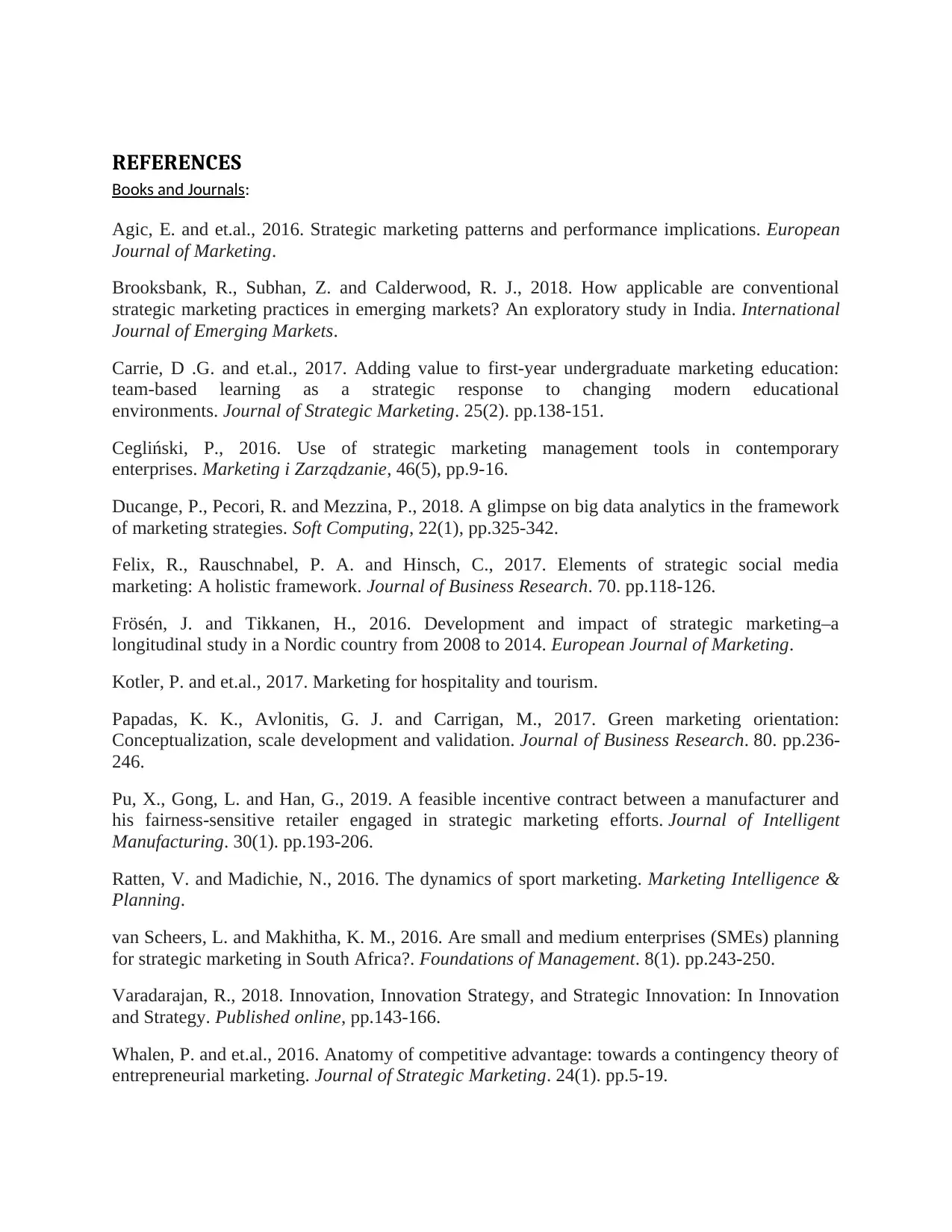
REFERENCES
Books and Journals:
Agic, E. and et.al., 2016. Strategic marketing patterns and performance implications. European
Journal of Marketing.
Brooksbank, R., Subhan, Z. and Calderwood, R. J., 2018. How applicable are conventional
strategic marketing practices in emerging markets? An exploratory study in India. International
Journal of Emerging Markets.
Carrie, D .G. and et.al., 2017. Adding value to first-year undergraduate marketing education:
team-based learning as a strategic response to changing modern educational
environments. Journal of Strategic Marketing. 25(2). pp.138-151.
Cegliński, P., 2016. Use of strategic marketing management tools in contemporary
enterprises. Marketing i Zarządzanie, 46(5), pp.9-16.
Ducange, P., Pecori, R. and Mezzina, P., 2018. A glimpse on big data analytics in the framework
of marketing strategies. Soft Computing, 22(1), pp.325-342.
Felix, R., Rauschnabel, P. A. and Hinsch, C., 2017. Elements of strategic social media
marketing: A holistic framework. Journal of Business Research. 70. pp.118-126.
Frösén, J. and Tikkanen, H., 2016. Development and impact of strategic marketing–a
longitudinal study in a Nordic country from 2008 to 2014. European Journal of Marketing.
Kotler, P. and et.al., 2017. Marketing for hospitality and tourism.
Papadas, K. K., Avlonitis, G. J. and Carrigan, M., 2017. Green marketing orientation:
Conceptualization, scale development and validation. Journal of Business Research. 80. pp.236-
246.
Pu, X., Gong, L. and Han, G., 2019. A feasible incentive contract between a manufacturer and
his fairness-sensitive retailer engaged in strategic marketing efforts. Journal of Intelligent
Manufacturing. 30(1). pp.193-206.
Ratten, V. and Madichie, N., 2016. The dynamics of sport marketing. Marketing Intelligence &
Planning.
van Scheers, L. and Makhitha, K. M., 2016. Are small and medium enterprises (SMEs) planning
for strategic marketing in South Africa?. Foundations of Management. 8(1). pp.243-250.
Varadarajan, R., 2018. Innovation, Innovation Strategy, and Strategic Innovation: In Innovation
and Strategy. Published online, pp.143-166.
Whalen, P. and et.al., 2016. Anatomy of competitive advantage: towards a contingency theory of
entrepreneurial marketing. Journal of Strategic Marketing. 24(1). pp.5-19.
Books and Journals:
Agic, E. and et.al., 2016. Strategic marketing patterns and performance implications. European
Journal of Marketing.
Brooksbank, R., Subhan, Z. and Calderwood, R. J., 2018. How applicable are conventional
strategic marketing practices in emerging markets? An exploratory study in India. International
Journal of Emerging Markets.
Carrie, D .G. and et.al., 2017. Adding value to first-year undergraduate marketing education:
team-based learning as a strategic response to changing modern educational
environments. Journal of Strategic Marketing. 25(2). pp.138-151.
Cegliński, P., 2016. Use of strategic marketing management tools in contemporary
enterprises. Marketing i Zarządzanie, 46(5), pp.9-16.
Ducange, P., Pecori, R. and Mezzina, P., 2018. A glimpse on big data analytics in the framework
of marketing strategies. Soft Computing, 22(1), pp.325-342.
Felix, R., Rauschnabel, P. A. and Hinsch, C., 2017. Elements of strategic social media
marketing: A holistic framework. Journal of Business Research. 70. pp.118-126.
Frösén, J. and Tikkanen, H., 2016. Development and impact of strategic marketing–a
longitudinal study in a Nordic country from 2008 to 2014. European Journal of Marketing.
Kotler, P. and et.al., 2017. Marketing for hospitality and tourism.
Papadas, K. K., Avlonitis, G. J. and Carrigan, M., 2017. Green marketing orientation:
Conceptualization, scale development and validation. Journal of Business Research. 80. pp.236-
246.
Pu, X., Gong, L. and Han, G., 2019. A feasible incentive contract between a manufacturer and
his fairness-sensitive retailer engaged in strategic marketing efforts. Journal of Intelligent
Manufacturing. 30(1). pp.193-206.
Ratten, V. and Madichie, N., 2016. The dynamics of sport marketing. Marketing Intelligence &
Planning.
van Scheers, L. and Makhitha, K. M., 2016. Are small and medium enterprises (SMEs) planning
for strategic marketing in South Africa?. Foundations of Management. 8(1). pp.243-250.
Varadarajan, R., 2018. Innovation, Innovation Strategy, and Strategic Innovation: In Innovation
and Strategy. Published online, pp.143-166.
Whalen, P. and et.al., 2016. Anatomy of competitive advantage: towards a contingency theory of
entrepreneurial marketing. Journal of Strategic Marketing. 24(1). pp.5-19.
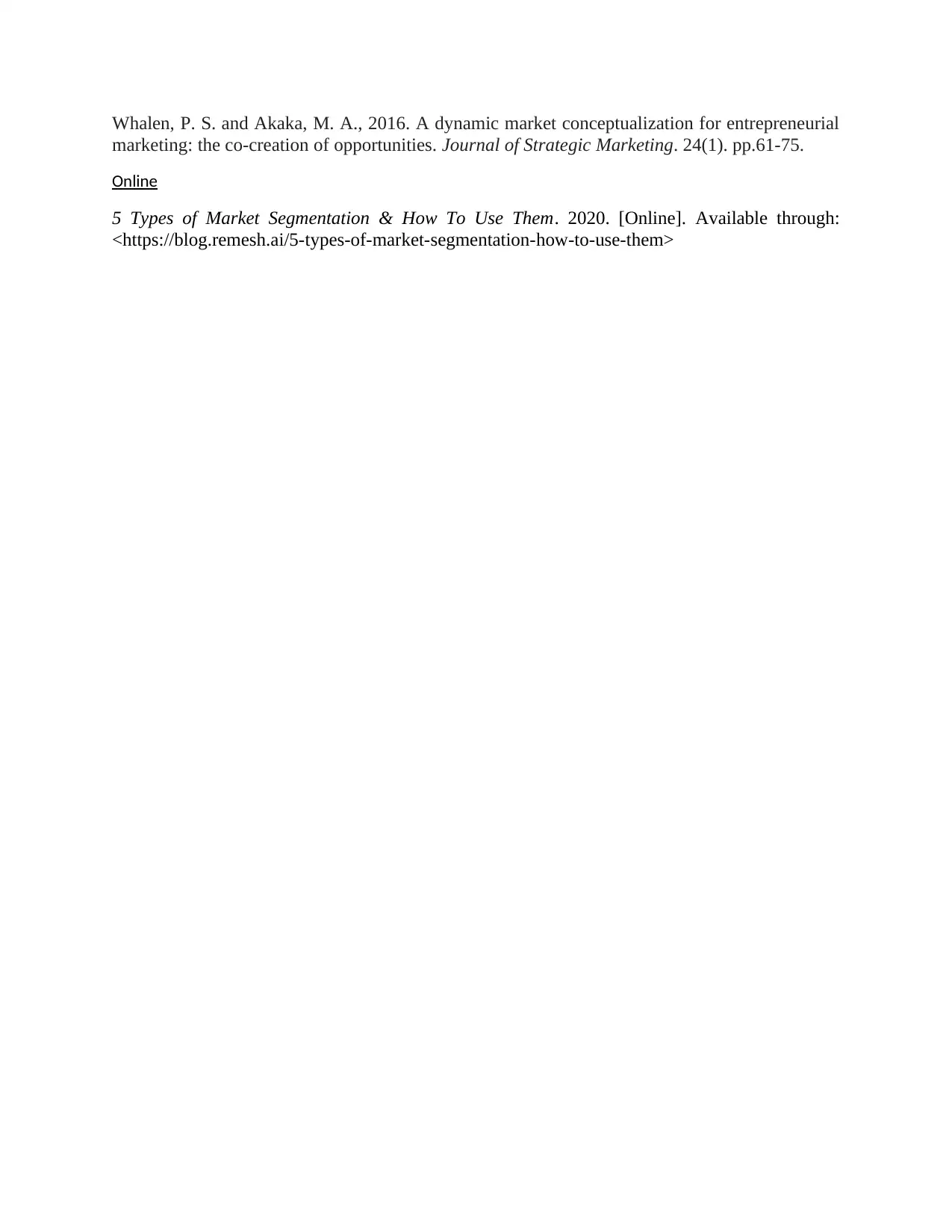
Whalen, P. S. and Akaka, M. A., 2016. A dynamic market conceptualization for entrepreneurial
marketing: the co-creation of opportunities. Journal of Strategic Marketing. 24(1). pp.61-75.
Online
5 Types of Market Segmentation & How To Use Them. 2020. [Online]. Available through:
<https://blog.remesh.ai/5-types-of-market-segmentation-how-to-use-them>
marketing: the co-creation of opportunities. Journal of Strategic Marketing. 24(1). pp.61-75.
Online
5 Types of Market Segmentation & How To Use Them. 2020. [Online]. Available through:
<https://blog.remesh.ai/5-types-of-market-segmentation-how-to-use-them>
1 out of 12
Related Documents
Your All-in-One AI-Powered Toolkit for Academic Success.
+13062052269
info@desklib.com
Available 24*7 on WhatsApp / Email
![[object Object]](/_next/static/media/star-bottom.7253800d.svg)
Unlock your academic potential
© 2024 | Zucol Services PVT LTD | All rights reserved.





